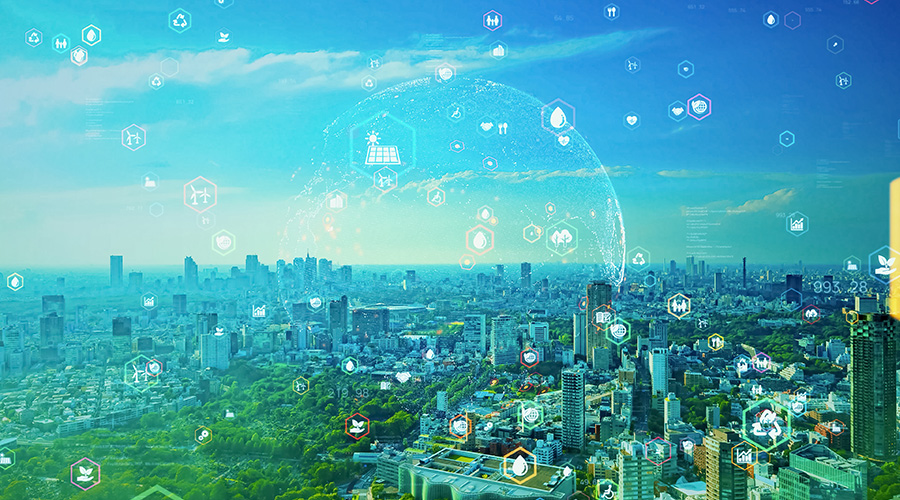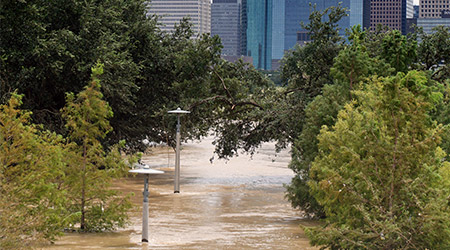 The hurricane season of 2017 was the most costly in U.S. history, with estimates of damage north of $250 billion. Three hurricanes in particular — Harvey, which hit southwest Texas, Irma, which hit Florida, and Maria, which devastated Puerto Rico — wrought massive damage. Each of these three storms also brought unique emergency preparedness and disaster recovery challenges for facility managers. The stories that follow show lessons learned from each of these three storms.
The hurricane season of 2017 was the most costly in U.S. history, with estimates of damage north of $250 billion. Three hurricanes in particular — Harvey, which hit southwest Texas, Irma, which hit Florida, and Maria, which devastated Puerto Rico — wrought massive damage. Each of these three storms also brought unique emergency preparedness and disaster recovery challenges for facility managers. The stories that follow show lessons learned from each of these three storms.Hurricane Harvey: FM's Quick Thinking Saves Houston Hospital From Evacuation
At Ben Taub Hospital, a combination of emergency preparedness and the ability to adapt quickly to changing conditions - including some flooding - meant the hospital stayed in operation.
Hurricane Harvey is the most destructive storm in U.S. history, causing an estimated $125 billion of damage. The storm dumped about 50 inches of rain on the Houston area in seven days, more than the average annual rainfall for most U.S. cities. As a result, Houston experienced some of the worst urban flooding since New Orleans after Hurricane Katrina in 2005.
Despite the devastation, many southwest Texas hospitals were able to withstand the storm and avoid evacuation. At the massive Texas Medical Center, a 2.1-square-mile district in southwest Houston that is home to the largest medical complex in the world, two healthcare facilities in particular — Ben Taub Hospital and the University of Texas MD Anderson Cancer Center — exemplify how the intersection of good planning and dedicated facilities teams can help weather a storm. These two hospitals hold lessons for emergency preparation and disaster recovery for any facility and any type of disaster.
Ben Taub Hospital
The best way to prepare for any storm, says Benny Stansbury, director of facilities management for Ben Taub Hospital, is to be always preparing. “I actually start preparing for hurricanes in January,” he says. “We’re constantly evaluating our supplies because a disaster could happen at any time. If you wait until a hurricane is bearing down, you’ll forget something, or something may not be available.”
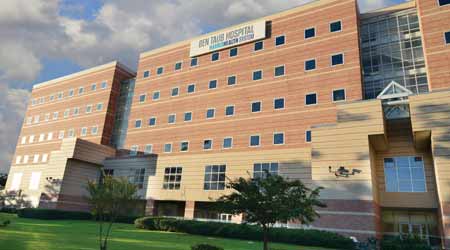
(Ben Taub Hospital nearly had to be evacuated during Hurricane Harvey, but quick thinking by the facility staff stopped flooding and kept the hospital occupied. Photo Courtesy Harris Health System)
Ben Taub Hospital is a 444-bed acute care facility and Level 1 trauma center located in the heart of the Texas Medical Center. Stansbury is a hurricane veteran, having withstood Hurricane Ike in 2008 and hugely devastating Hurricane Rita in 2005. So as Hurricane Harvey made landfall, Stansbury and his 16-member “ride-out” team prepared for the worst.
“You expect to encounter wind and rain, and you expect leaks, and that is exactly what we got,” says Stansbury. “I got leaks from places I never thought possible.”
As the storm raged, a 6-inch pipe suffered a 30-foot gash, unleashing a torrent of stormwater into the facility’s basement. “We got very frantic,” says Stansbury. “How am I going to stop this water? If we don’t stop this, we are going to lose the hospital.” He says the mood on his team was darkening rapidly, but he lined up his team, gave them a pep talk, and the ideas started flowing.
On a whim, Stansbury called Houston’s non-emergency 311 number, and was amazed when he got a call back from a city official 15 minutes later offering to help with some pumps. “My team was in the process of making canals with sandbags down the hallways to direct water to drains,” says Stansbury. “But as soon as the pumps started, we could tell it was working and the water receded.”
But the hospital wasn’t out of danger yet. Ben Taub is located near a bayou and the pressure from the overflowing bayou on storm sewers caused another pipe in a different part of the facility to blow a cap. Pretty soon, there was nearly six feet of water flooding into a mechanical room, coming dangerously close to swamping some vital electrical and telecommunications equipment. Had this equipment been drenched, the hospital would have had to been evacuated.
Thinking quickly, Stansbury says they found a 2x6 board and used that as a temporary cap while one of his team literally went swimming to find the blown-off cap. Meanwhile, as they re-secured the pipe cap, other members of the team grabbed an electric concrete drill – fully aware of the hazard of using electricity around flooding water – to drill holes in a cinder block wall and “vent” the water. “Our guys were all standing in a line, holding up the extension cord,” says Stansbury. “We were just hoping no one dropped their part of the cord.”
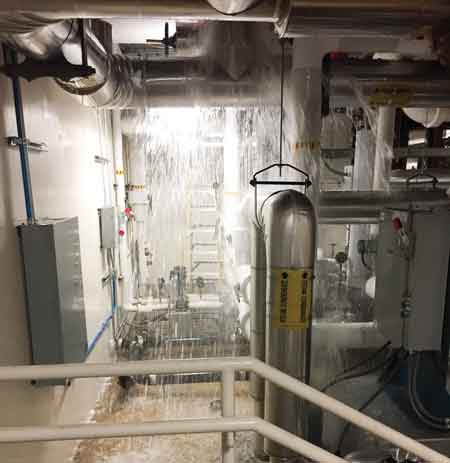
(After a pipe cap blew off, water cascaded into a mechanical room at Ben Taub Hospital. But facilities staff stopped the flooding before major equipment damage occurred. Photo Courtesy Harris Health System)
The efforts were successful and soon the water started to recede and could be controlled more effectively, saving the sensitive electrical and telecommunications equipment. Again, the possibility of evacuating the hospital was avoided. “As long as we didn’t lose power and we could control the water, we were good,” says Stansbury.
Soon, with the major issues under control, Stansbury began thinking about recovery. “I’d gotten a jump on this one,” he says. “As the storm continued, I’d been in constant contact with my disaster recovery and plumbing contractors. These two companies were ready to get here as soon as the storm ended.” That’s a key take-away for any facility manager hoping for business continuity: Don’t just plan for the storm, be ready to hit the ground running as soon as it’s over. Stansbury says he and his team used infrared moisture meters to identify leaks and other areas affected, and began replacing drywall and sheet rock immediately.
It took about three weeks, he says, for full recovery – that is, to have every patient room back online and operation back to fully normal. Even as a hurricane veteran, Stansbury learned some valuable lessons from this storm. He says he recommends having tools on hand to be able to direct water out of the building. His team was successful in doing so, but there were some anxious moments, he says. Also, he says he’d have some more trades on hand for the ride-out team, including plumbers and electricians (the latter especially to manage generators and transfer switches).
But the staff he had for this one, he says, performed splendidly. “I had an incredible team,” he says. “This was a whole team effort. We are tasked with looking after this hospital, and we are going to do that, no matter what.”
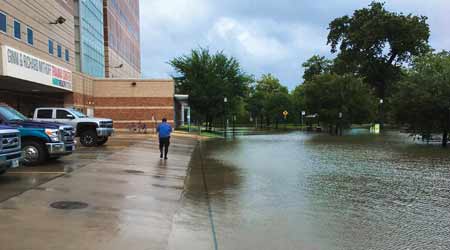
(Water recedes from the ambulance dock at Ben Taub Hospital. Photo Courtesy Harris Health System)
Related Topics:


















